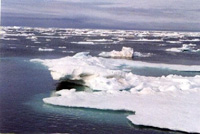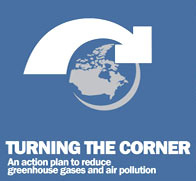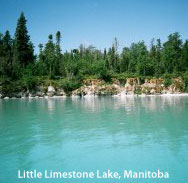
News |
- Small Glaciers Add to Sea Levels
- Premiers to Move Beyond Federal Inaction
- Canada's Plan to Regulate GHGs
- Nahanni National Park Reserve To Expand
- Temperature and Rainfall Study Released
- Mining Industry Adopts Biodiversity Policy
- Next National Forest Strategy for Canada
- Toronto's Bold Climate Change Plan
- Manitoba Climate Change Guide Launched
- New Manitoba Park Reserve - Little Limestone Lake
- Locals Oppose Wind Projects
- Chicago Climate Exchange - Hydro Report
| Small Glaciers Add to Sea Levels | 14 August 07 |
 Ice melt from small glaciers and ice caps will be the major source of sea-level rise this century, according to new research.
Ice melt from small glaciers and ice caps will be the major source of sea-level rise this century, according to new research.The study, published in July 19th edition of Science, comes from an international team led by Mark Meier (University of Colorado). It found glacial melt and the "calving" of icebergs into the ocean will account for 60% of sea-level rise from melting ice, which equals 10 to 25 centimetre rise by 2100. Previously, scientists suggested the ice sheets of Antarctica and Greenland would be most responsible for rises, as they hold the majority of frozen water. "They will be, on time scales of centuries or millennia," says Meier. "But for the next few generations, it is the small glaciers that will be most important." Glaciers and ice caps, according to Meier, are particularly susceptible to large decreases in size because "they're thinner, warmer, and more delicate. Many glaciers are at or close to the melting point," Meier said. Glaciers are also contributing more to rising seas because of rapid changes in how they flow, co-author Robert Anderson said in a statement. As glaciers become thinner, they slide more quickly toward the sea. View July 19, 2007 New Scientist article View July 19, 2007 National Geographic News article View July 19, 2007 Reuters article View July 19, 2007 Science abstract for Glaciers Dominate Eustatic Sea-Level Rise in the 21st Century Source: New Scientist, National Geographic News, Reuters
|
|
| Premiers to Move Beyond Federal Inaction | 10 August 07 |
 Climate Action Network (CAN-RAC) Canada called on Canada's premiers to overcome what it describes as "federal inaction" on climate change and take the necessary steps to significantly reduce greenhouse gas emissions.
Climate Action Network (CAN-RAC) Canada called on Canada's premiers to overcome what it describes as "federal inaction" on climate change and take the necessary steps to significantly reduce greenhouse gas emissions.CAN Canada, a nation-wide network comprised of over 60 national and regional environmental groups, sent a letter to provincial and territorial premiers on the eve of the 2007 Council of the Federation meetings in Moncton. Toby Couture of the Conservation Council of New Brunswick said Canadians want to see the premiers lead on climate change. "Greenhouse gas emissions have increased in Canada by 25 per cent since 1990, and have grown in each province as well," he said. "We need leadership and the provinces can help to provide it." Manitoba Premier Gary Doer is pushing for provinces to be bolder in combating climate change; Doer and B.C. Premier Gordon Campbell want the provinces to set up a system to cap greenhouse-gas emissions at a certain level, but allowing provinces or industries who can't meet the cap to trade for credits with those whose emissions fall below it. Manitoba Wildlands is a member of CAN and Director Gaile Whelan Enns says Manitoba needs to get its own climate change affairs in order and update its 2002 Climate Change Plan in order to maintain credibility. "Manitoba's 2002 Climate Action Plan is dated, with no data based public report on action over the past five years. Manitobans expect the government's upcoming plan to account for emissions reductions since 2002 as well as commit to new steps, with targets and deadlines: inside Manitoba." View August 9, 2007 Canadian Press article View August 9, 2007 Climate Action Network Canada press release View CAN Canada letter to Council of the Federation (PDF) View August 9, 2007 Winnipeg Free Press article View August 8, 2007 CTV News article View August 9, 2007 The Star View August 8, 2007 Toronto Star article View Council of the Federation's energy vision, trade, and emissions communiques Source: CAN Canada, Canadian Press, Winnipeg Free Press, Manitoba Wildlands
|
|
| Canada's Plan to Regulate GHGs | 10 August 07 |
 As Canada's government moves closer to finalizing its system to regulate greenhouse gases, environmental groups are critiquing the suggested system and making use of public comment and review options.
As Canada's government moves closer to finalizing its system to regulate greenhouse gases, environmental groups are critiquing the suggested system and making use of public comment and review options.The Pembina Institute and Toxics Watch Society of Alberta submission on the proposed Greenhouse Gas Regulatory Framework is based on their May 2007 analysis of the government's April 2007 Greenhouse Gas Policy Announcement. Their analysis identified multiple gaps that could undermine the government's ability to secure emission reductions it has claimed the regulatory framework will achieve. Manitoba Wildlands also provided comments on key elements of the proposed Greenhouse Gas Regulatory Framework. The emphasis was to lay the groundwork for forests to be included in Canada's domestic greenhouse gas regulatory system and ultimately in the international framework to address climate change. This means finding forest management practices to keep carbon secure, and acknowledging the importance of forest protection and the carbon storage functions of intact forests. Carbon storage and CO2 functions from Manitoba's intact boreal forests mitigate effects of climate change, while protecting the ecological services from intact boreal systems. As of August 10, 2007 none of the public comments, or the details for this review were available online. View July 31, 2007 Pembina Institute and Toxics Watch Society of Alberta submission View May 2007 Pembina Institute publication, Analysis of the Government of Canada's April 2007 Greenhouse Gas Policy Announcement View July 31, 2007 Manitoba Wildlands submission (PDF) Source: Pembina Institute, Toxics Watch Society of Alberta, Manitoba Wildlands
|
|
| Nahanni National Park Reserve To Expand | 10 August 07 |
 Canadian Prime Minister (PM) Stephen Harper began a three-day tour of Canada's North by announcing the long-awaited expansion of Nahanni National Park Reserve.
Canadian Prime Minister (PM) Stephen Harper began a three-day tour of Canada's North by announcing the long-awaited expansion of Nahanni National Park Reserve.Nahanni National Park Reserve was the first site in the world to be granted World Heritage status in 1978, and is home to mineral hot springs, vast forests and a large variety of species including grizzly bears, caribou and Dall's sheep. Conservation groups have issued warnings that the reserve's ecological treasures are threatened by new mining, oil and gas development, and have urged federal officials to expand the protected area by up to 30,000 square kilometers - to encompass the entire watershed. In contrast, the PM's August 8, 2007 announcement adds 5,000 square kilometers to the reserve, bringing the total area under interim protection to 28,000 square kilometres. Conservationists applauded the Nahanni addition but noted action is needed to secure protection for a suite of important ecological and cultural areas identified in the Northwest Territories Protected Areas Strategy, national park proposals and regional land use plans. Similarly, the Dehcho First Nations, which still have unsettled land claims, cautioned the announcement is only be a small step in a long negotiating process to protect the park. View the August 8, 2007 CBC News article View the August 9, 2007 CanWest News article on Canada.com View the August 8, 2007 Canadian Boreal Initiative press release View the Government of Canada website for the Nahanni National Park Reserve Source: CBC News, Canadian Boreal Initiative, CanWest News Service, Government of Canada
|
|
| Temperature and Rainfall Study Released | 02 August 07 |
 A landmark Canadian-led study has drawn a clear link between human activity since early 20th century and shifting rainfall patterns around the globe. The study is the first to confirm a link between rainfall patterns and global warming, according to co-author Francis Zwiers, director of the Climate Research Division of Environment Canada.
A landmark Canadian-led study has drawn a clear link between human activity since early 20th century and shifting rainfall patterns around the globe. The study is the first to confirm a link between rainfall patterns and global warming, according to co-author Francis Zwiers, director of the Climate Research Division of Environment Canada.The scientists looked at data sets of rainfall patterns over a 75-year period from 1925 to 1999 and compared them with 14 climate models. The research shows human activity is creating a stronger water cycle, and rainfall has shifted away from the region north of the equator - including sub-Saharan Africa, southern India and southeast Asia - and moved north to Canada and Europe, and south to below the equator. The data confirmed what the scientists had speculated could occur from human activity, and in some cases the weather changes went beyond what scientists had predicted. At least 50 per cent, and as much as 85 per cent, of average rainfall increases at northern latitudes between 1925 and 1999 can be attributed to human activity. "Temperature changes we can cope with. But water changes are much more difficult to cope with. That will have economic impacts, and impacts on food production, and could ultimately displace populations," says Zwiers. View the July 23, 2007 Globe and Mail article (DOC) View the July 23, 2007 CBC News article View the July 23, 2007 CanWest News Service article in the Victoria Times Colonist View the Letter in the July 26, 2007 edition of the journal Nature (PDF) Source: Globe and Mail, CBC News, CanWest News Service
|
|
| Mining Industry Adopts Biodiversity Policy | 30 July 07 |
 Canad mining industry adopted a precedent-setting biodiversity policy that includes a pledge to recognize the planet's 851 World Heritage properties as "No Go" areas and to finance projects that will return mining sites to viable and diverse ecosystems.
Canad mining industry adopted a precedent-setting biodiversity policy that includes a pledge to recognize the planet's 851 World Heritage properties as "No Go" areas and to finance projects that will return mining sites to viable and diverse ecosystems.The MAC Board adopted the Biodiversity Framework June 20, 2007. It builds upon MAC members' commitments to Towards Sustainable Mining (TSM.) TSM is a MAC initiative focused on improving mining industry sustainable development performance. The Mining Association of Canada's (MAC) Mining and Biodiversity Policy Framework includes commitments to:
View July 11, 2007 MAC press release (PDF) View July 2007 MAC publication, Mining and Biodiversity Conservation -Towards Sustainable Mining Framework (PDF) Source: Mining Association of Canada
|
|
| Next National Forest Strategy for Canada | 30 July 07 |
 The Canadian Council of Forest Ministers (CCFM) has initiated the process to develop the next National Forest Strategy for Canada. Canada's Forest Strategy is evaluated and updated every five years. The first Forest Strategy and Accord was released for the Earth Summit in 1992.
The Canadian Council of Forest Ministers (CCFM) has initiated the process to develop the next National Forest Strategy for Canada. Canada's Forest Strategy is evaluated and updated every five years. The first Forest Strategy and Accord was released for the Earth Summit in 1992.As a first step for renewal of Canada's Forest Strategy, the CCFM released a discussion paper for public review. The paper describes the overall process, including proposed vision, principles, goals and objectives for sustainable forest management in Canada, as well as potential issues to be addressed by the strategy. Public comments on the discussion paper were accepted until July 20, 2007. There will be further opportunities for public and input into the next National Forest Strategy. A national workshop has been scheduled for spring 2008 to review the draft Strategy, and there will be opportunities for web-based public input. The CCFM is expected to approve Canada's next National Forest Strategy at their fall 2008 annual meeting. To date it is not clear what role the National Forest Strategy Coalition will play in renewing Canada's Forest Strategy, or how the deliverables from the 2003 strategy will be evaluated. View the June 5, 2007 Canadian Council of Forest Ministers press release View the May 2007 Canadian Council of Forest Ministers report, Canada's Forest Strategy For 2008 and Beyond - A Discussion Paper (PDF) Visit the Canadian Council of Forest Ministers website Visit the National Forest Strategy Coalition website Source: Canadian Council of Forest Ministers
|
|
| Toronto's Bold Climate Change Plan | 30 July 07 |
|
In addition to meeting the Kyoto target of 6 percent below 1990 levels by 2012, Toronto has also committed to reducing greenhouse gases 30 percent by 2020, and 80 percent by 2050 (based on 1990 levels). The plan also sets a target to reduce smog-causing pollutants by 20 percent by 2012. To accomplish this, Toronto will initially be allocating $42 million for energy conservation measures, $20 million for renewable energy projects and $22 million for retrofitting City facilities. View the June 17, 2007 Toronto Star article Visit the City of Toronto's Change is in the Air website View the City of Toronto report, Change is in the Air - Climate Change, Clean Air and Sustainable Energy Action Plan (PDF) Source: City of Toronto, Toronto Star
|
|
| Manitoba Climate Change Guide Launched | 26 July 07 |
 A Winnipeg conservation group recently released its comprehensive action guide designed to educate citizens, and especially Manitobans, on the effects of and real solutions for global warming.
A Winnipeg conservation group recently released its comprehensive action guide designed to educate citizens, and especially Manitobans, on the effects of and real solutions for global warming.Authored by the Winnipeg Group of the Sierra Club of Canada, the publication is designed to speak to Manitoba politicians as well as citizens. Its 21 recommendations critique current climate change plans and outline steps that must be taken by politicians and decision-makers to prevent catastrophic loss of our ecosystem. Among the recommendations are: tax on carbon emissions, and raise hydro rates, as economic incentives for citizens to become more energy efficient. The report also recommends investing in better public transit, setting clear targets for greenhouse gas reductions and banning incandescent light bulbs. Steve Rauh, vice-chair of the Winnipeg chapter of the Sierra Club of Canada said greenhouse gas emissions in Manitoba amounted to 17.1 tonnes per person in 2005, up from 11 tonnes a decade earlier. And 17.1 tonnes per person is "an energy crisis," said Rauh. View Sierra Club of Canada Winnipeg Group's 2007 report, Climate Change Action Guide for Manitoba Citizens (PDF) View June 26, 2007 Winnipeg Free Press article (DOC) Visit Sierra Club of Canada Prairie Chapter website Source: Sierra Club of Canada - Prairie Chapter, Winnipeg Free Press
|
|
| New Manitoba Park Reserve - Little Limestone Lake | 24 July 07 |
 Conservation Minister Stan Struthers and Science, Technology, Energy and Mines Minister Jim Rondeau announced the creation of a new Park Reserve - Little Limestone Lake Park Reserve, July 19, 2007. This is Manitoba's first new Park Reserve established in over four years. The park reserve regulation is for six months, at which time it can be extended for up to five years, as interim protection.
Conservation Minister Stan Struthers and Science, Technology, Energy and Mines Minister Jim Rondeau announced the creation of a new Park Reserve - Little Limestone Lake Park Reserve, July 19, 2007. This is Manitoba's first new Park Reserve established in over four years. The park reserve regulation is for six months, at which time it can be extended for up to five years, as interim protection.Located 450 kilometres north of Winnipeg, the 4,095 hectare park reserve includes the 15-km long lake and its islands as well as a 100-metre-wide strip of shoreline. The eastern shore is located within the federal reserve land of Mosakahiken Cree Nation. "Our First Nations people were the first stewards of nature's land and consider conservation and protection of this extraordinary site to be a priority," said Chief Phillip Buck of the Mosakahiken Cree Nation. Little Limestone Lake is considered the finest and largest example of a marl lake in the world. Xstrata Nickel was cooperatively involved with the interim protection of Little Limestone Lake Park Reserve, as it overlies the Thompson Nickel Belt, an area of high mineral potential. Xstrata agreed to remove its mining claims under and adjacent to the lake. View July 19, 2007 Manitoba Government press release View Protected Areas Initiative webpage for Little Limestone Lake Park Reserve View July 19, 2007 Provincial Parks Act Regulation 94/2007 (PDF) Source: Government of Manitoba, Manitoba Wildlands
|
|
| Locals Oppose Wind Projects | 23 July 07 |
 Opposition is growing in Manitoba to giant wind turbines as the novelty of being paid for wind wears off.
Opposition is growing in Manitoba to giant wind turbines as the novelty of being paid for wind wears off.In St. Joseph, south of Winnipeg, a concerned citizens group is protesting a proposal by Bowark Energy Ltd. to install 63 wind turbines across a 13-kilometre stretch of arable land. In Elie, just west of Winnipeg, residents are demanding a study on long-term costs of a wind turbine proposal by Sequoia Energy. Community complaints include noise, loss of property value, problems with approach for compensation, and concern about junking up the uninterrupted prairie horizon. Manitoba does not have wind project environmental assessment guidelines. Guidelines would require developers to, for instance, adhere to required setback distances from residences, and be developed with public input. No standards exist for access to information regarding potential or existing wind projects. Gaile Whelan Enns commented "Despite NDP commitments to avoid staged licensing, communities literally do not know what size a wind project will end up becoming. Lack of environmental license standards is causing confusion, and showing Manitoba to be unorganized in delivery of alternative energy." View July 18, 2007 Winnipeg Free Press article (DOC) Visit the Canadian Wind Energy Association (CanWEA) website View 2005 Ontario Sustainable Energy Association report, Ontario Landowner's Guide to Wind Energy (PDF) View July 2006 Environment Canada/Canadian Wildlife Services report, Wind Turbines and Birds A Guidance Document for Environmental Assessment (PDF) View July 21, 2007 Winnipeg Free Press editorial (DOC) View July 23, 2007 Winnipeg Free Press Re: Wind turbines causing trouble in rural areas, July 18 (DOC) Visit Sequoia Energy website Source: Winnipeg Free Press, Manitoba Wildlands
|
|
| Chicago Climate Exchange - Hydro Report | 23 July 07 |
 Despite being one of 13 founding Charter Members of the Chicago Climate Exchange (CCX), Manitoba Hydro's compliance report for its greenhouse gas emissions and voluntary reductions is absent from posted 2003-2005 Individual Member Compliance Reports.
Despite being one of 13 founding Charter Members of the Chicago Climate Exchange (CCX), Manitoba Hydro's compliance report for its greenhouse gas emissions and voluntary reductions is absent from posted 2003-2005 Individual Member Compliance Reports.Launched in 2003, the Chicago Climate Exchange (CCX) asserts it is the world's first and North America's only legally binding rules-based greenhouse gas emissions allowance trading system, as well as the only global mechanism for trading of all six greenhouse gases. CCX has nearly 300 members from all sectors and offset projects worldwide. CCX Members make a voluntary but legally binding commitment to meet annual greenhouse gas (GHG) emission reduction targets. Those who reduce more than the targets have surplus allowances to sell or bank; those who emit above their targets comply by purchasing CCX Carbon Financial Instrument (CFI) contracts. Each 'contract' or trade represents 100 metric tons of CO2 equivalent. Gaile Whelan Enns commented, "It is time for all Manitoba Hydro data about emission targets, carbon loss, methane, and mercury build up to be public. As a public utility Manitoba Hydro must practice transparency both for CCX and in reporting to Canada's greenhouse gas inventory." Visit the Chicago Climate Exchange website View a list of compliance reports to October 2006 Source: Chicago Climate Exchange
|
|


 RSS Feeds:
RSS Feeds: